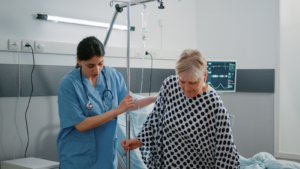Congress Newsletter 2022
Session preview: ethics and patient rights at the start of life
Session 04P1, Today, Sunday 5 June, 1515-1615H, Space 1
There are few areas of medicine more emotionally charged than those on ethics and patient rights at the start of life. As part of a 3-part session on Sunday, Assistant Professor Caitlin Dooley Sutton of Baylor College of Medicine, Houston, Texas, USA will give her talk ‘Maternal versus foetal rights in early pregnancy: caesarean section for imminent foetal demise against maternal wishes’.
Her talk will be given in the context of maternal refusal of Caesarean delivery, and she explains: “We think about the ethics of these cases in terms of beneficence (what choice leads to the greater balance of goods with regards to the health-related interests of the patients) and autonomy (respect for the patient’s values, beliefs, and decisions). One nuance that can be tricky is that beneficence is generally restricted to health-related outcomes because it is based on medical evidence, not the subjective outlook of a particular doctor, whereas autonomy can include interests outside health, like religion or preferences on how/whether/when to have children.”
Q: Caitlin, welcome to Euroanaesthesia 2022 in Milan. When you talk about the influence of current professional, legal, and cultural norms/standards, could you explain a little what those norms are – is there a certain way of dealing with these difficult situations?
A: Thank you! From a professional standards perspective, ACOG, RCOG, AMA, and AAP all recommend against court-ordered interventions. Laws vary from country to country and state to state, but most legal systems do not require a person to save another person’s life, especially if doing so would put them at risk – we wouldn’t seek a court order to force a father to donate his kidney or bone marrow to his child, for example. However, performing surgery on a patient without informed consent does violate established legal standards in most cases.
Q: The conflicts that can arise when these obligations support different courses of action – would an example be an imminent danger to the mother from the fetus, including the situation you describe of the imminent demise of the fetus with no hope of recovery?
A: Almost always, what is good for the mom is good for the baby — these conflicts come up when that’s not the case. It’s rare, but it does happen. It can be helpful to think about these conflicts in terms of when an intervention would help the mom but not the baby, or vice versa. For example, imagine a mom has terminal cancer and needs chemo/radiation, but that would harm the baby. Another case might be where the mom comes into the hospital and the baby isn’t doing well, but the mom has a medical condition that makes emergency surgery dangerous for her. The thing that makes these situations even more complex is that we can make educated, evidence-based predictions about what might happen to our patients, but they’re never 100% certain. So there have been cases where doctors appropriately quote a very high risk of death for the mom or baby, but the mom still declines the surgery, and she and the baby both do well. The uncertainty that exists makes this so much harder.
Q: What are some of the factors that can influence the patient’s decision on their treatment? Would one be the chances of survival of the fetus if the pregnancy continues? Their own risk of death? Partner/ family considerations?
A: Some factors that have been described for patients refusing Caesarean delivery include fear of pain or death (maybe they had a family member who died during delivery), concerns about the cost (in countries without universal coverage of healthcare costs — it’s hard to understand if you’re not living in a system like that, but it is a huge factor for some), religious or cultural concerns, ideologic opposition to the medicalisation of childbirth (societal influence/misogyny has led many people to feel shame about Caesarean versus vaginal delivery), previous experience/trauma, or even just miscommunications.
Q: Competent patients are afforded the right to make decisions about their own health care and pregnancy does not negate that right. This seems like an absolutely impossible situation for the medical team – are there examples of both the pregnant women eventually reluctantly agreeing to a course of action that preserves them, while ending the life of the fetus (rather than both dying?), and others where pregnant women will not take the step no matter what, risking their own life? At what point can you reasonably intervene in the latter situation (or can you not?)
A: There are examples of practically every situation you can imagine – cases where a woman refused recommended Caesarean and delivered safely vaginally, cases where women have been forced to undergo Caesarean by court order and were traumatised by it, and many other examples. Ideally, these cases are identified early and there is a thoughtful approach to understanding her perspective and reasoning. Sometimes there is a miscommunication or misunderstanding that can be resolved through effective and non-judgmental communication. The key is to identify these cases as early as possible because time constraints can make finding a solution many times more difficult. That said if a well-informed patient with the capacity refuses surgery no matter what, it would be hard to ethically justify proceeding against her expressed refusal.
Q: Can you describe the emotional stress that weighs heavy on everyone in these situations? Clearly a desperate situation for any family – but also for you yourself and your colleagues – how do manage your own emotional stress when confronted with this on a regular basis?
A: I strongly recommend a debrief with ALL team members that are involved in the care. These cases are challenging for everyone, and they’re never straightforward. It can help to involve ethics consultants early on, as they have experience in mediation and communication in complex situations, and they can also help support teams who experience moral distress. We have to take care of each other and ourselves in order to have the strength to take the best care of our patients going forward.
I think it’s important to remember that our goals are to take care of the patient in the best way we can — ideally in a way that has a good medical outcome AND is consistent with the patient’s values and choices. When those two goals can’t both be reached, we have to have a thoughtful approach to make sure we are supporting our patients with the information and understanding they need, and never leave them feeling abandoned because the medical team wouldn’t necessarily make the same choice for themselves. We also need to follow up and make sure that our team is doing okay — the moral distress that can be experienced by the healthcare team is real — and it can have long-lasting effects.
Read More of our special newsletter covering our congress.











